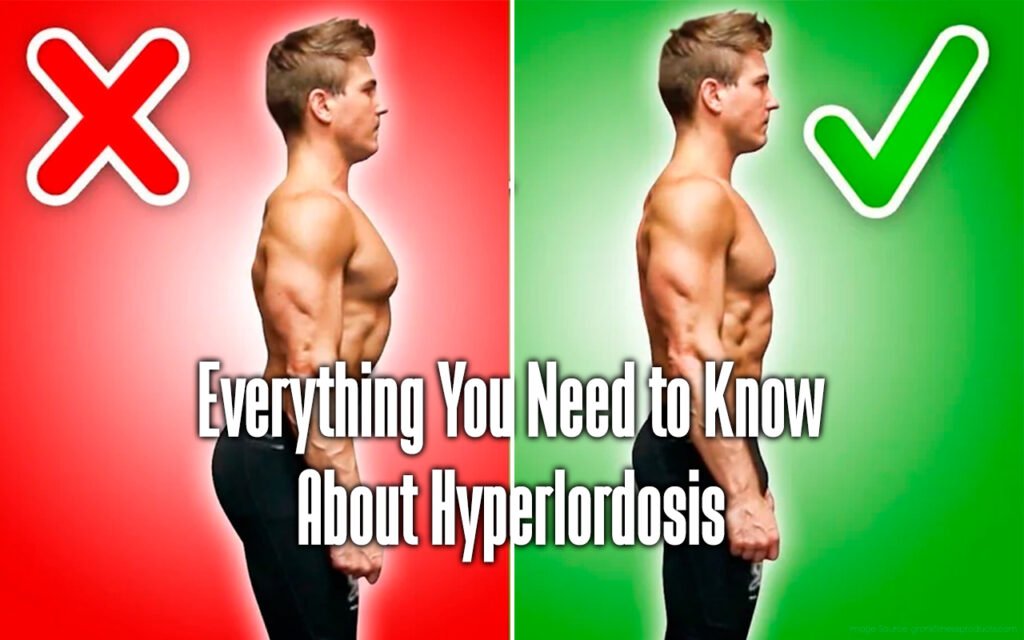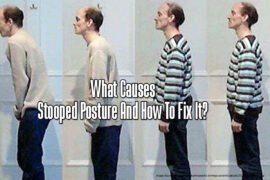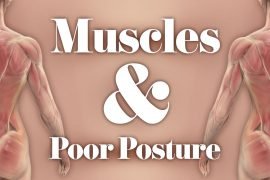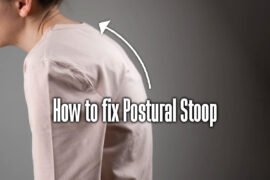[Updated on 1 May 2023] Your lower back is curved inward to a small degree, with your spine sloping like an “S” form. When your lumbar spine has an excessive arch, it becomes a dangerous condition known as hyperlordosis. Have you noticed that your lower back’s arch forces your tummy to protrude forward? If you don’t already suffer from back pain, it might cause it to you in the future. A person with an exaggerated inward curve in their lower spine would have an outward bend in the upper spine, causing their shoulders to hunch forward and the chest to collapse inward.
Hyperlordosis must be addressed if you want to avoid back discomfort and obtain good posture and skeletal alignment. Fortunately, it is a correctable disease that may be treated by adopting healthy habits and exercises. Continue reading to know more about the causes of hyperlordosis, how to identify it, and what you can do if you have it.
What Is Hyperlordosis?
Table of Contents
The human spine has a natural curve, but an excessive curve can lead to problems. Hyperlordosis is excessive inward curvature of the lower spine. The condition referred to is known as either swayback or saddleback. While hyperlordosis is a condition that can happen at any age, it is uncommon in children, and it is a reversible condition.
Causes Of Hyperlordosis
Hyperlordosis is most commonly caused by bad posture. Other factors that can contribute to hyperlordosis are:
- rickets
- spinal injury
- weak core muscles
- obesity
- neuromuscular diseases
- sitting or standing for extended periods
- wearing high-heeled shoes for extended periods
Hyperlordosis is the way the female spine adapts to the extra weight of the baby during pregnancy. This adaptation is specific to pregnant women. You can check your posture by doing a simple test:
- Assume a straight posture with your back against a wall, ensuring that your legs are at a shoulder-width distance and your heels are approximately 2 inches away from the wall.
- Make sure that your head, shoulder blades, and bottom are touching the wall. Leave a small gap between the wall and the small of your back that is big enough to slide your hand through.
- If you have hyperlordosis, there will be a gap of more than one hand’s width between the wall and your back.
Symptoms Of Hyperlordosis
If you have hyperlordosis, the exaggerated curvature of your spine will cause your stomach to protrude forward and your bottom to push out. If you look at your profile in a full-length mirror, you will notice that the inward curve of your spine appears arched like the letter C. You might experience pain in your lower back or neck and limited mobility. Although some evidence links hyperlordosis to lower back pain, it is limited.
Hyperlordosis is usually mild and does not affect the flexibility of your back. If your back’s arch is stiff and doesn’t improve when you lean forward, it could indicate a severe issue.
Determining The Types Of Hyperlordosis
The type of treatment a patient needs for hyperlordosis depends on whether their condition is flexible, hypermobile, or rigid. The hypermobile type of abnormality allows the spine to maintain its normal range of motion. Improving posture through exercise is an effective method for addressing this particular condition. If the area of the spine that is affected is stiff, then it is called rigid hyperlordosis. The severity of symptoms is determined by the type of hyperlordosis involved, which can include various specific types:
- Muscle weakness
- Lower back or neck pain
- Limited range of motion
- Restrictions with movement
Identifying A Likely Source Of Hyperlordosis
The likely source of the abnormal inward curvature determines how the condition will be treated. Poor posture over many years can often result in the development of hyperlordosis. Other factors that can affect the shape of the spine include:
- Pregnancy
- Excess weight
- Neuromuscular disease
- Sudden spinal injuries
- Weak spine-supporting muscles
- Habits that throw off spinal alignment, such as wearing high heels
How To Diagnose Hyperlordosis
Diagnosing hyperlordosis can be challenging because there is a wide range of lumbar lordosis (natural lower spine curvature) present in the population.
A healthcare professional usually orders an X-ray to measure the spinal curvature. In case the cause of hyperlordosis is suspected to be related to an abnormality in the soft tissue, the healthcare provider may suggest undergoing an MRI or CT scan.
In addition, they might recommend a blood test and bone scans to gather further details and eliminate any other potential health issues.
Treatment Options That Taken For Hyperlordosis
The treatment typically includes methods that aid in preventing further curvature of the lower back. The doctor might prescribe pain relief and anti-inflammatory medication as a first step to relieving painful symptoms.
If someone is considered obese, a healthcare professional will probably create a plan to help them lose weight. Physical therapy exercises to stretch & strengthen core muscles may be recommended to improve your posture. Sometimes, a doctor may recommend the use of a back brace called a hyperlordosis brace to maintain proper alignment of the spine.
The type of treatment required over a longer period of time will vary depending on what is causing the condition. If the reason for hyperlordosis is a weakness or muscle imbalance, you may require a recommendation to visit a physical therapist or a back specialist. If other treatments fail to improve the symptoms, surgery may be necessary to correct the curve in more severe cases.
What can people do to prevent hyperlordosis?
Practicing correct posture can often help people prevent hyperlordosis. Properly aligning your spine can prevent placing unnecessary stress on your neck, hips, and legs, potentially avoiding future problems. The following tips should be followed to help prevent this condition:
- If the patient is concerned about weight management, they should initiate a weight loss program. If you need help getting started, you can consult with a doctor.
- People who sit for extended periods during the day should take frequent short breaks to stand up and stretch.
- It is important for individuals who stand for long periods of time to regularly alternate their weight between their feet, shifting from one foot to the other or from their heels to their toes.
- The people are required to keep their feet in a flat position on the floor.
- It is important for them to use a pillow or a rolled towel to provide support for their lower back while sitting. It is mandatory to wear comfortable, low-heeled shoes.
- The people need to adhere to a selected exercise program.
Treating Flexible/Mild Hyperlordosis
Hyperlordosis that doesn’t affect the flexibility of the spine usually results in mild symptoms. Therapeutic exercises that focus on core muscle groups and improve posture are often effective for patients in this situation. Doctors may recommend younger adults and teenagers with the condition wear a brace temporarily in order to fix their spinal alignment. Other ways to obtain relief without having surgery might include:
- Spinal strength training
- Weight loss for obese or overweight patients
- You can take either over-the-counter or prescription anti-inflammatory or pain medications.
- Yoga is a type of exercise that is gentle on the body but also works to strengthen the muscles that support the spine.
Treating Rigid Hyperlordosis
The increased immobility in the affected area of the spine, specifically in hyperlordosis, usually leads to other parts of the spine, including supporting discs, being affected as well, which results in a rigid form. If someone is experiencing discomfort due to compressed nerves, physical therapy may be used to alleviate the symptoms. In order to assess the impact on soft tissues and nerves, it may be necessary to conduct neurological tests.
Opting For Surgery
In most cases, hyperlordosis does not require surgery. Typically, spinal fusion is performed to limit movement around specific vertebrae and restore stability in the affected area of the spine. Today, numerous procedures and techniques that are minimally invasive are frequently performed, which leads to reduced risks during surgery and faster recovery time. If other treatments fail to relieve the condition, surgery can be effective when done in combination with physical therapy.
To prevent hyperlordosis, it is helpful to maintain good posture while sitting, standing, and sleeping to avoid putting so much pressure on the spine. Patients experiencing mild symptoms due to posture issues can often rectify the curvature naturally over a period of time.
Best Exercises To Fix Hyperlordosis
Fortunately, hyperlordosis can be corrected with proper exercise and posture adjustments. In this article, we’ll discuss the five best exercises to fix hyperlordosis.
Pelvic Tilt
The pelvic tilt is an excellent exercise for fixing hyperlordosis because it targets the muscles that are responsible for maintaining proper pelvic alignment. To perform this exercise:
- Lie flat on the back with bent knees and your feet flat on the ground.
- Place hands on your hips and tilt your pelvis backward until your lower back touches the floor.
- Hold this posture for a few seconds, then release and repeat.
Glute Bridge
Glute bridge is another effective exercise for correcting hyperlordosis. This exercise strengthens the glutes, which are the muscles responsible for extending the hips and maintaining proper pelvic alignment. To perform this exercise:
- Lie flat on your back to bent knees and your feet flat on the ground.
- Place the arms at your sides and lift your hips up towards the ceiling until your body forms a right straight line from shoulders to knees.
- Hold this posture for a few seconds, then release and repeat.
Side Plank
Side plank is the best exercise for strengthening the oblique muscles, which can help correct hyperlordosis. To perform this exercise:
- Lie on your side with your elbow straightly beneath your shoulder and your legs stacked on top of each other.
- Lift your hips off the ground and create a straight line from head to feet.
- Hold this position for several seconds, then lower your hips back down to the ground.
- Repeat this exercise on the other side.
Cat-Cow Stretch
The cat-cow stretch is a simple yoga pose that can help improve spinal mobility and reduce lower back pain. Assume a hands-and-knee position with your wrists beneath your shoulders & your knees under your hips to begin this exercise. Arch your back while inhaling, and raise your head and tailbone towards the ceiling. Round your back by exhaling and bring your chin to your chest while also bringing your tailbone towards your knees. Perform this movement multiple times.
Dead Bug
Although stretching is commonly recommended to address lumbar lordosis, recent research indicates that muscle strengthening is also crucial. The dead bug exercise is well-known for being effective in enhancing core strength. Maintaining proper posture and alignment of the spine may become easier as a result.
Please lie down on your back and press your lower back onto the floor. Observe any tension that may be present in your shoulders and release it. Finally, lift your arms up. Position your elbows directly above your shoulders and ensure that both hands face inward toward each other. Raise your legs so your knees are directly above your hips, forming a 90-degree angle between your thighs and calves. Make sure you don’t let your right arm and left leg touch the floor as you exhale while lowering them. Bring both your arm & leg back to the initial position while inhaling. Then, repeat on the other side.
Hip Flexor Stretch
A hip flexor is a group of muscles that attach to the front of the pelvis and play a significant role in maintaining proper pelvic alignment. Tight hip flexors can contribute to hyperlordosis, so stretching them is an essential component of any hyperlordosis correction program. To perform this stretch:
- Kneel on one knee with your other feet flat on the ground in front of you.
- Tilt your pelvis forward until you feel the stretch in the front of your hip.
- Hold this posture for a few seconds, then release and switch sides.
Knee To Chest Stretch
Stretching your thigh muscles and hamstrings can improve your posture by providing support to your legs. Please lie down on the ground with your legs fully stretched out. To do this exercise, raise one leg and put your hands on top of your knee. Then, carefully pull your knee towards your chest. You should sense a stretching sensation in your lower back and buttock. Please hold for 5 to 10 seconds. Afterward, switch to the other leg and then repeat the process with both legs together. Complete three sets daily, each consisting of up to 10 repetitions.
Bird Dog
Bird dog exercise is a great way to strengthen the core muscles and lower back. To perform this exercise, get on your hands & knees with your hands shoulder-width apart & your knees hip-width apart. Extend your right arm and left leg until they are straight and parallel to the ground. Hold this posture for a few seconds, and then lower your arm and leg back down to the ground. Repeat this exercise with your left arm and right leg.
Cobra Stretch
Cobra stretch is a yoga pose that can help alleviate hyperlordosis by stretching the lower back muscles. To perform this stretch, lie on your stomach with your hands under your shoulders & your elbows close to your sides. Then, press your hands into the floor and lift your chest off the ground, keeping the elbows close to your sides. Hold this posture for 30 seconds and then release.
Things To Avoid While Suffering From Hyperlordosis
Here are some things to avoid while suffering from hyperlordosis:
- Poor posture. This is the most important thing to avoid. When you have poor posture, your muscles and ligaments are forced to work overtime to support your spine, which can lead to pain and inflammation. Make sure to sit up straight, stand up straight, and walk with your shoulders back and your head held high.
- Slouching. Slouching is a form of poor posture that can put plenty of strain on your lower back. If you are slouching, try to catch yourself and correct your posture.
- Sitting for long periods of time. Sitting for a long time can weaken your core muscles and make it more difficult to maintain good posture. If you sit for a long time, so get up & move around every 30 minutes or so.
- Wearing high heels. High heels can put a lot of stress on your lower back. If you have hyperlordosis, it’s best to avoid wearing high heels.
- Lifting heavy objects. Lifting heavy objects may put a lot of strain on your lower back. If you have to lift heavy objects, make sure to use proper form and lift with your legs, not your back.
- Excessive exercise. Excessive exercise can put a lot of stress on your lower back. If you have hyperlordosis, it’s important to find a balance between exercise and rest. Please talk to your doctor about how much exercise is right for you.
- Neglecting your core muscles. Your core muscles are important for supporting your spine. If you have hyperlordosis, it’s important to strengthen your core muscles. Talk to your doctor about how many exercises that are safe for you to do.
FAQs
Q1. Is hyperlordosis reversible?
While some curvature is natural, having too much can lead to potential complications. Hyperlordosis is a reversible condition that can occur in people of all ages.
Q2. What makes hyperlordosis worse?
Hyperlordosis is often caused by poor posture, which is a common factor. Muscles in the lower back can become overly tight when sitting as they work to keep the spine stable and supported. The gradual pulling of the spine leads to misalignment and increased curvature.
Q3. How should I sleep with hyperlordosis?
Sleeping on our backs can cause pain at night by pulling our hips slightly forward and increasing the lumbar lordosis. Consider placing a pillow under your knees or calves to relieve some of the lumbar lordosis and help relax your back muscles. Please be cautious of potential pressure on the heels.
Q4. Is hyperlordosis rare?
Typically, hyperlordosis is uncommon in children, and it is mainly observed in those who have neuromuscular conditions affecting their nervous system and muscle problems.
Q5. Does hyperlordosis reduce height?
Just having lumbar hyperlordosis will not cause you to lose a vertebra, but it can lead to the bending of the vertebrae and a decrease in your overall spine height.
Q6. Is hyperlordosis genetic?
This is a type of dwarfism where the limbs are shorter than usual due to a genetic mutation. People with this condition often have a noticeable curvature of the lower spine called lumbar hyperlordosis.
Q7. Can hyperlordosis cause paralysis?
In all cases, there was a dominant lumbar hyperlordosis, which was accompanied by paralytic thoracolumbar scoliosis in seven cases. In all cases, the reason for the difficulty in sitting and the inability to use a wheelchair was due to lumbar hyperlordosis.
Q8. What muscles are weak in hyperlordosis?
The weak and stretched muscles are the rectus abdominus, internal oblique, and external oblique muscles of the abdomen.
Q9. Can you be born with hyperlordosis?
The condition refers to an abnormal inward curvature of the lower back spine bones. Lordosis can be present in a newborn baby. Another possible cause of its development is other health problems and poor posture.
Q10. Do you need surgery for hyperlordosis?
Only severe cases of lordosis in patients require surgery or treatment, as most cases do not need any medical intervention. Patients are commonly treated with medications like acetaminophen (Tylenol™), ibuprofen (Advil™), or Naprosyn (Aleve™) on an as-needed basis to alleviate occasional back pain.
Conclusion
The extreme inward curvature of the lower back is known as hyperlordosis. If someone develops hyperlordosis in adulthood, it is likely due to certain lifestyle factors, although some people may be born with it. Regular exercise and maintaining an average weight can often improve posture and reduce back pain issues. When exercise does not relieve the symptoms of hyperlordosis, people must seek medical advice. The doctor will examine the spine before creating a treatment plan specifically for the patient.







